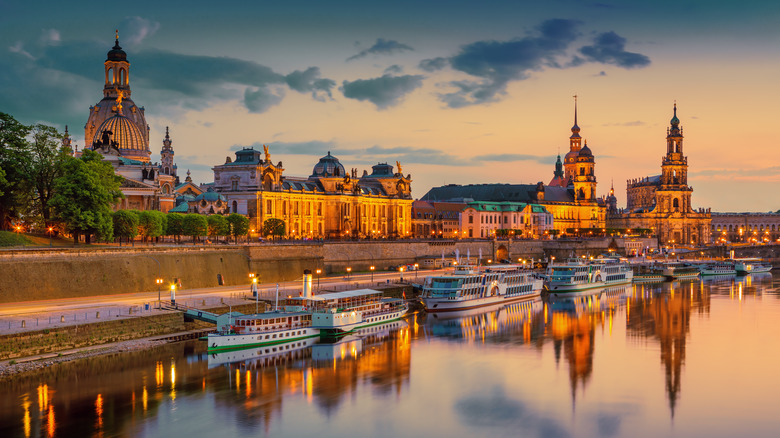Rick Steves Says This Stunning European Destination Feels Like A Secret You Should Know
Dresden is so beautiful that travelers have been known to almost drop their apfelstrudel. This trendy European city is the capital of Saxony; it is located in eastern Germany, 30 miles from the Czech Republic. Dresden is often called the "Florence on the Elbe," as it's blessed with an archive of beautiful Baroque facades, chiseled churches, and a peacefulness that seems to persist across the city. Remnants of history are found everywhere in its cityscape. The Wettin Dynasty ruled it for eight centuries before the end of World War I and later faced near-destruction from the Allied Forces in World War II.
After years of renovation, Dresden remains a time capsule into the turbulent past that settled over this country, which nearly crumbled under the effects of warfare. According to travel expert Rick Steves, Dresden remains a hidden secret to many American tourists. Despite the streets buzzing with visiting guests, many are of Russian or German descent, with few Americans seen exploring the charm of this ancient city.
Traveler Blog the magic of the Balcony of Europe
On one visit to Dresden, Steves was enamored by the beauty of this colorful city, walking away with a curated list of favorites to see, taste, and experience. The Albertinum enthralls art critics with an eye for tasteful designs. This modern art museum features one of the finest art collections in Germany, with iconic pieces from the Romantic period to the modern day. Exhibitions include works by famous artists, including Renoir, Rodin, and Van Gogh.
Staying on trend with Dresden's eye-catching feats of art, the Dresden Zwinger might be the most famous landmark in the entire city. Adorned with porcelain bells, its open-air courtyard wraps around the baroque fortress with a dazzling display of manicured lawns and sparkling fountains. Inside, the Dresden Zwinger houses the Staatliche Kunstsammlungen Dresden and a multimedia experience that provides a glimpse into Germany's culture and annual festivals.
They don't call Dresden the "Balcony of Europe" for nothing. According to Steves, this riverside terrace is one of the most charming European promenades. Comparable to New York City's High Line, no trip to Dresden would be complete without perusing the scenic 1,640-foot-long balcony. This captivating stroll overlooks the Elbe River, the Bruhlsche Terrasse, and the Blaues Wunder Bridge. Located in the heart of the city and delivering panoramic views of the region, it's possible to view nearly every corner of Elbe Valley and beyond.
Old Town or new ... take your pick!
Many travelers tend to underestimate this city's offerings beyond the popular palaces and historical landmarks that draw tourists to Dresden. Neustadt (New Town) is worth the trek across the Elbe river banks for its bohemian eateries and thriving nightlife scene. Home to artsy murals fashioned into wallpaper on the cobblestone alleyways and Dresden's Baroque Quarter, travelers can get lost in this German community for days.
Its most coveted hidden gem is Dresden's famous fairytale-themed dairy shop. Officially registered under the moniker Molkerei Gebrüder Pfund, this cheese and milk shop, more often than not, goes by its more esteemed title, "The Most Beautiful Dairy Shop in the World," granted by the Guinness Book of World Records. The Renaissance-style ceilings are accented by ceramic tiles painted with cherubs and woodland motifs, adding an element of culture to the cozy ambiance.
Despite its name, Dresden's Old Town district has been almost fully renovated. The urban landscape is home to some of the city's most iconic structures, including a few hole-in-the-wall vaulted restaurants and scenic bike paths along the River Elbe. It's also the site of several of the town's Christmas markets, should you find yourself here during winter. Dresden embraces the Yuletide season, transforming into a winter wonderland for a picture-perfect getaway. Steves recommends the Dresden's Striezelmarkt for Christmas festivities. This European Christmas market dates back to 1434 and is the oldest in Germany — a true piece of local culture in this German town!


